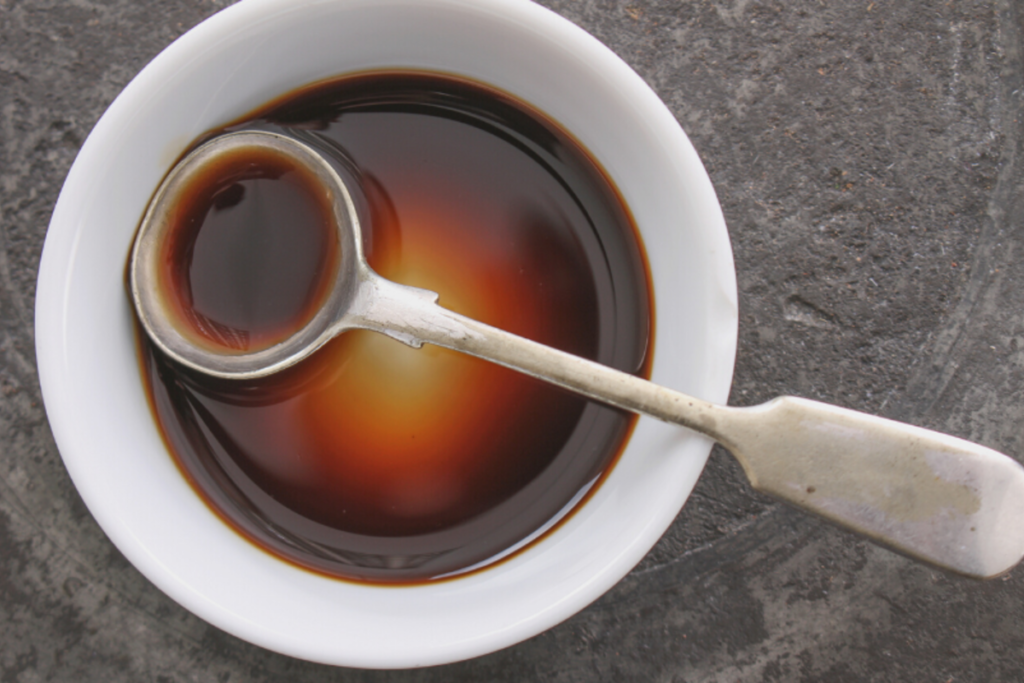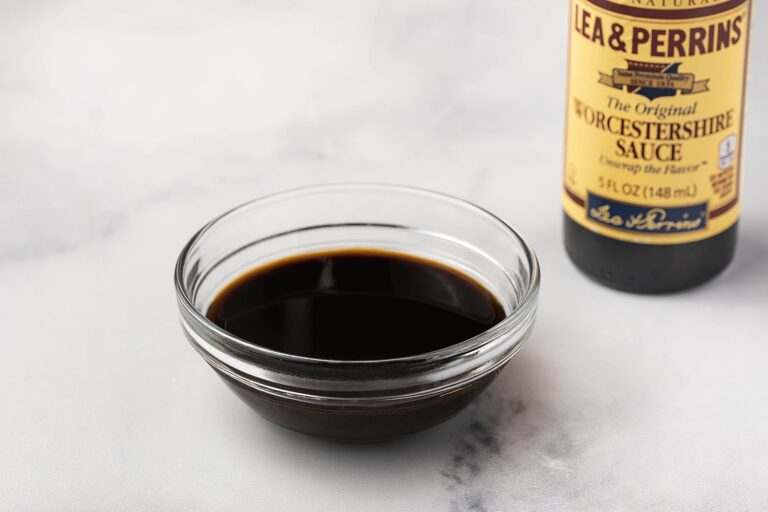Worcester sauce is a bit like fish or soy sauce known for its tasty umami kick. It gets this rich flavor from anchovies.
The sauce that’s a mix of tangy, salty, and sweet – that’s Worcester. It’s not just for show; a little bit in sauces, soups, or meats adds an extra yummy layer. It’s strong by itself, but a small amount can turn your dish into a perfect blend of sweet and savory.
Moreover, it gives you a balanced taste of tanginess, savory richness, sweetness, and saltiness, all thanks to the anchovies. Just keep in mind, that different brands might have their own spin. For example, Lea & Perrins in the U.S. can be a tad saltier and sweeter than the one in the U.K.
Now, unveil the mystery, savor the complexity, and let Worcester sauce redefine your gastronomic adventures.
What Is Worcester Sauce?

Worcester sauce is a fermented liquid condiment created in the city of Worcester in Worcestershire, England. It has a complex flavor profile that is both savory and tangy, with a hint of sweetness and umami.
The exact recipe for Worcester sauce is often a closely guarded secret, but common ingredients include anchovies, garlic, onions, tamarind, molasses, vinegar, salt, and various spices.
What Is the History of Worcester Sauce??
In the early 1800s, Lord Sandys brought a sauce recipe from Bengal, India, to Worcester, England. Not knowing how to cook, he asked local chemists, John Lea and William Perrins, to make it. The chemists, later known as Lea and Perrins, weren’t pleased with the first try. Instead of tossing it, they stored the jars in their cellar. After 18 months, they found the jars and, surprisingly, the sauce had improved with age.
Furthermore, the sauce’s origin is a bit unclear. Brian Keogh, a former Lea & Perrins accountant, mentioned in a 1997 document that there’s no record of Lord Sandys in Bengal or India. The sauce’s complete history is lost.
Regardless, Lea and Perrins liked the sauce so much that they decided to share it. Also, named it after their county, Worcester, and started bottling and selling it across Europe. The sauce gained a reputation for enhancing the flavor of food.
Lastly, in 1839, a New York entrepreneur tried Lea & Perrins Worcester Sauce and decided to bring it to the U.S. It became extremely popular, becoming the only commercially bottled condiment in the U.S. Today it especially from Lea & Perrins, is a kitchen staple loved for enhancing the taste of various dishes.
What Are The Varieties Of Worcester Sauce?
- Gluten-Free Option:
- Made with distilled white vinegar for gluten-free appeal.
- Check the label to confirm gluten-free status.
- Vegetarian or Vegan Version:
- Anchovy-free for plant-based preferences.
- Clear labeling highlights vegan or vegetarian suitability.
- Low-Sodium Alternatives:
- Crafted for reduced sodium content.
- Ideal for low-sodium diets or those favoring a milder taste.
- Diverse Brand Exploration:
- Sample various brands to discover personal preferences.
- Experiment by incorporating it into recipes alongside other savory sauces.
- Savory Sauce Pairing:
- Enhance culinary experiences by combining with soy, oyster, or fish sauce.
- Experiment with different combinations to find unique flavor profiles.
How To Store Worcester Sauce?
Worcester sauce boasts an impressive shelf life, ensuring its longevity whether you’re an occasional user or a frequent diner. This versatile condiment confidently holds its flavor for approximately a year when stored in your pantry a cool, dry haven for culinary essentials. Should you opt for an even extended period of delectability, consider the refrigerator, where It boldly preserves its distinctive taste for up to three years.
Interestingly, even if your bottle ventures beyond its expiration date, rest assured, it remains safe for consumption, though the flavor may not command the same robust presence. Explore the enduring essence of it in your culinary repertoire.
Worcester Sauce Substitutes: Quick and Easy Alternatives for Flavorful Cooking
If you find yourself without Worcester sauce or need a vegetarian option, try these simple substitutes:
- Soy Sauce:
- A great vegetarian alternative.
- Imparts a similar savory flavor, though less sweet and tangy.
- Adjust the recipe to balance the flavors. Mix soy sauce with ketchup and white wine vinegar for a Worcestershire-like taste.
- Fish Sauce or Anchovy Paste:
- Provides a depth of flavor similar to Worcester.
- Less sweet and tangy, so adjust accordingly.
- Balsamic or Sherry Vinegar:
- Lends tangy sweetness like Worcester
- Use less than you would Worcester, as these vinegars are more concentrated.
- Consider adding extra spices or heat to compensate for nuanced flavor differences.
Tamarind Paste Hack:
- Combine tamarind paste with a bit of fish sauce, soy sauce, or ketchup for a simple substitute that captures the tangy essence of it.
Savory Boosters with Worcester Sauce
- Caesar Salad:
- Elevate your Caesar dressing with Worcester sauce for a signature, savory kick.
- Try it in classic and grilled variations.
- Meat-Based Dishes:
- Perfect for red meat and pork dishes, enhancing less flavorful cuts.
- Add a kick to ground meat, meatloaf, or hamburger patties.
- Amp up saucy meat dishes like steak and ale pie.
- Cheesy Dishes:
- Cut through richness in cheesy pasta, like mac and cheese.
- Elevate vegan ‘cheese’ pasta with vegan Worcester.
- Marinades and Sauces:
- Enhance homemade sauces, such as ketchup or barbecue sauce.
- Consider adding to marinades for a tangy, savory flavor.
- Egg Dishes:
- Experiment with Worcester sauce in scrambled eggs or shakshuka.
- Pan Sauces, Deglazing, and Gravy:
- Add a few drops during deglazing for homemade pan sauces and gravies.
- Control flavor more easily than with gravy powder or stock cubes.
- Achieve a well-rounded, homemade taste.
How to Properly Use Worcester Sauce?

Worcester sauce is a versatile enhancer for umami-rich ingredients like red meat, mushrooms, eggplant, cheese, and tomatoes. Rather than slathering it on at the table, treat it as a concentrated boost during cooking. Here are some tips:
- Use Sparingly:
- Apply it sparingly during cooking for optimal flavor enhancement.
- Think of it as a concentrated essence to enrich dishes, sauces (gravies, steak, or cocktail sauces), and drinks.
- Creating Rich Bases:
- Incorporate Worcester sauce to create a rich, savory base in various dishes.
- Enhance the depth of flavors in meat-based recipes, gravies, and sauces.
- In Drinks:
- Key ingredient in Bloody Mary or Virgin Mary cocktails.
- Adds body to tomato juice, preventing it from being overly watery.
- Combine with Tabasco for an extra kick.
Homemade Worcester Sauce Recipe
Unlock the essence of Worcester sauce with this simple homemade recipe:
Ingredients:
- 1 cup apple cider vinegar
- 2 tablespoons water
- 2 tablespoons brown sugar
- 2 tablespoons fish sauce (or soy sauce)
- 2 tablespoons tamarind paste
- 1 teaspoon freshly ground black pepper
- ½ teaspoon mustard powder
- ½ teaspoon onion powder
- ½ teaspoon ground cloves
- ½ teaspoon cayenne pepper
Instructions:
- In a medium saucepan over high heat, combine all ingredients and bring the mixture to a boil. Reduce the heat to a simmer, whisking occasionally, until the sauce reduces to a syrupy consistency—typically around 10–25 minutes.
- Transfer the homemade one to a clean jar and refrigerate. It can be stored for up to 2 months.
Elevate your culinary skills with exclusive video lessons from renowned chefs, including Gabriela Cámara, Chef Thomas Keller, Yotam Ottolenghi, Dominique Ansel, Gordon Ramsay, Alice Waters, and more, through the MasterClass Annual Membership. Unleash your inner chef and enhance your cooking repertoire.
FAQ’s
What flavor does Worcestershire sauce add?
Worcestershire sauce adds a powerful umami flavor, derived from anchovies or soy sauce. It also provides a combination of sourness from tamarind and vinegar, sweetness from molasses and sugar, and spiciness.
What is Worcestershire sauce similar to?
Worcestershire sauce can be substituted with alternatives like balsamic vinegar, soy sauce with sugar, BBQ sauce, tomato ketchup, fish sauce, coconut aminos, anchovies, or hot sauce.
Does Worcestershire sauce taste like soy sauce?
Yes, Worcestershire sauce has a similar umami quality to soy sauce but with less sodium and no soy or gluten.
Is Worcestershire sauce salty or sweet?
Yes, Worcestershire sauce tastes tangy, savory, sweet, and salty, with a well-balanced flavor profile.
Is Worcestershire sauce fishy?
Yes, Some Worcestershire sauces include anchovies, making it unsuitable for those allergic to fish. However, vegetarian or vegan varieties without anchovies are available.
Is Worcestershire sauce sweet or spicy?
Yes, Worcestershire sauce has a powerful umami flavor with a balance of sourness, sweetness, and spiciness.
Is Maggi similar to Worcestershire sauce?
Yes, Maggi sauce is likened to Worcestershire sauce, offering a funkier flavor than soy sauce. It is made from hydrolyzed wheat protein and should be used in smaller quantities to avoid excessive saltiness.
What spice can replace Worcestershire sauce?
Soy sauce or soy sauce with sugar, along with a pinch of brown sugar, garlic powder, or onion powder, can serve as substitutes for Worcestershire sauce.
What is Worcestershire sauce best with?
Worcestershire sauce enhances the flavors of hearty meat dishes, such as braises, stews, and grilled burgers, thanks to its depth from anchovies and the balanced combination of vinegar and saltiness.
Why is Worcestershire sauce so delicious?
Worcestershire sauce is known for its punchy umami flavor, similar to fish sauce or soy sauce, achieved through the inclusion of anchovies.
Does Worcestershire sauce taste like oyster sauce?
Yes, Worcestershire sauce shares a backbone of fish flavors with oyster sauce, owing to the anchovies in its recipe, but it has a distinct profile that can be balanced with soy sauce and sugar for a closer match to umami.
Final Words
Worcester sauce presents a distinctive and harmonious flavor combination, offering tanginess, savory richness, sweetness, and saltiness in a well-balanced profile. The pronounced umami derived from anchovies contributes to its excellence as a condiment.
Notably, spice variations may be found between different brands and even within the same brand, as exemplified by Lea & Perrins, where regional differences can influence the taste. Overall, its unique and versatile flavor makes it a valuable addition that elevates the taste of a wide range of dishes, showcasing its significance in culinary creations.

